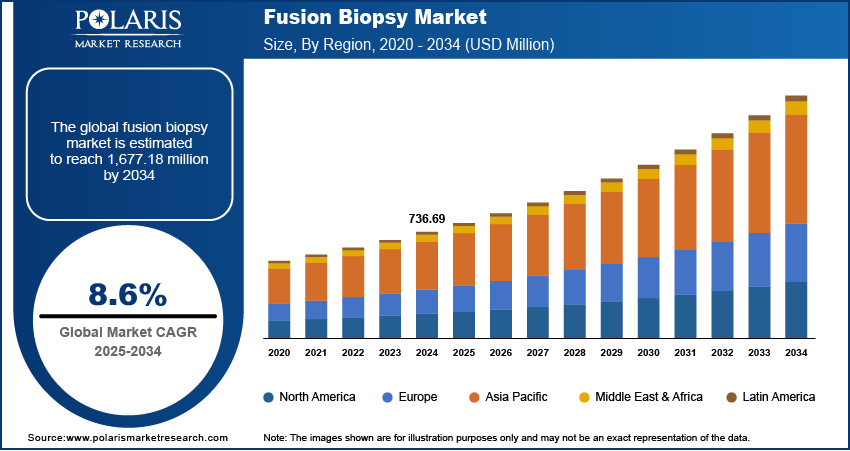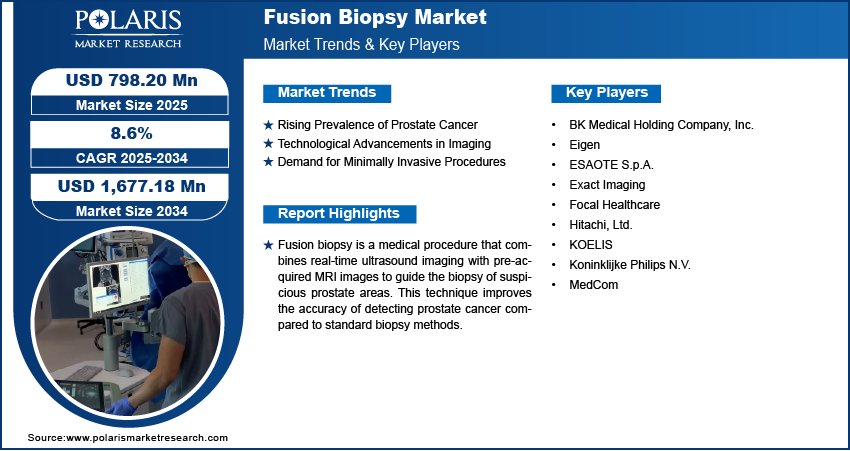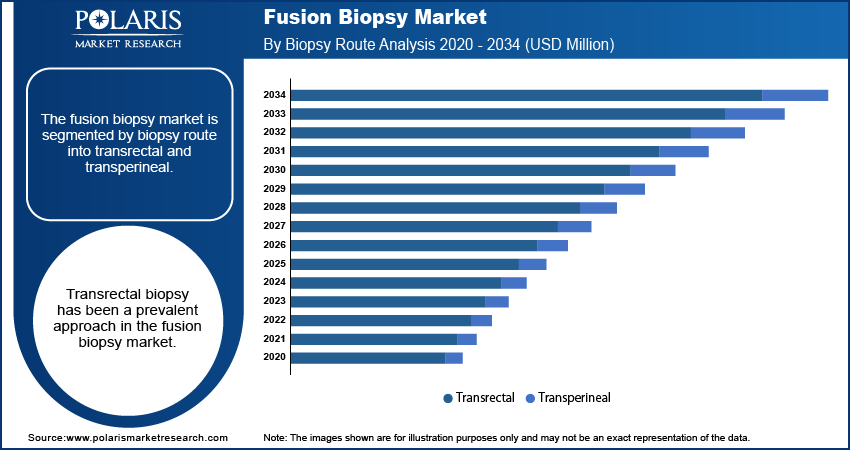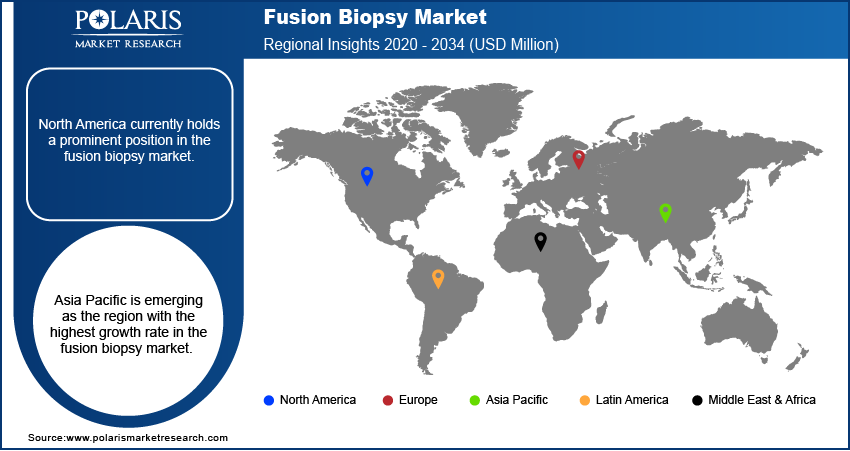
Fusion Biopsy Market Size, Share, Trends, Industry Analysis Report
: By Biopsy Route (Transrectal and Transperineal), End Use, and Region (North America, Europe, Asia Pacific, Latin America, and Middle East & Africa) – Market Forecast, 2025–2034
- Published Date:Sep-2025
- Pages: 120
- Format: PDF
- Report ID: PM5662
- Base Year: 2024
- Historical Data: 2020-2023
Market Overview:
The fusion biopsy market size was valued at USD 736.69 million in 2024, exhibiting a CAGR of 8.6% during 2025–2034. Rising prostate cancer cases, demand for early and accurate diagnosis, advanced imaging innovations, and preference for minimally invasive techniques drive market growth.
Key Insights
- Transrectal biopsy dominates due to familiarity among clinicians, ease of access, and widespread availability of compatible systems in clinical settings.
- Hospitals lead due to strong infrastructure, advanced imaging capabilities, and the ability to deliver integrated diagnostic services efficiently.
- Ambulatory care centers show strong growth thanks to demand for cost-effective, outpatient, and minimally invasive diagnostic procedures.
- North America holds the largest share due to advanced healthcare systems, high awareness, and strong reimbursement support for prostate diagnostics.
- Asia Pacific shows the highest growth, driven by an aging population, healthcare investments, and increasing adoption of modern diagnostic methods.
Industry Dynamics
- Rising global cancer incidence increases demand for precision therapies that limit damage to healthy tissue while improving treatment outcomes.
- Advancements in robotics and real-time imaging improve targeting accuracy, enabling safer and more effective tumor treatment across complex anatomical sites.
- Integration of AI allows real-time adaptation of treatment plans, boosting precision and efficiency in personalized radiotherapy delivery.
- The high cost of robotic radiotherapy systems limits adoption across low-resource settings and smaller healthcare institutions, affecting market penetration.
Market Statistics
2024 Market Size: USD 1,237.19 million
2034 Projected Market Size: USD 3,732.43 million
CAGR (2025–2034): 11.7%
North America: Largest market in 2024

To Understand More About this Research:Request a Free Sample Report
The fusion biopsy market encompasses the diagnostic procedures that combine real-time imaging, such as Magnetic Resonance Imaging (MRI) or ultrasound, with targeted biopsy techniques to enhance the precision of tissue sampling. This market's expansion is notably driven by the increasing prevalence of prostate cancer and the growing demand for minimally invasive surgery and diagnostic procedures. The need for accurate and early detection of prostate cancer, coupled with advancements in imaging technologies, significantly influences the market's trajectory. Furthermore, the rising awareness among healthcare professionals regarding the benefits of fusion biopsies over traditional methods is contributing to its wider adoption.
A key market drive is the continuous innovation in imaging software and hardware, which allows for improved visualization and targeting of suspicious lesions. This market development is directly impacting market penetration as more healthcare facilities recognize the value of these advanced diagnostic tools. The growing geriatric population, which is more susceptible to prostate cancer, further fuels the market demand. Additionally, favorable reimbursement policies in certain regions are expected to bolster the market growth factors and contribute to the overall market size. The market outlook indicates a strong potential for expansion, driven by the persistent need for precise diagnostic solutions in oncology.
Market Dynamics:
Rising Prevalence of Prostate Cancer
The increasing incidence of prostate cancer and prostate cancer treatment globally is a significant factor propelling the growth of the fusion biopsy market. As prostate cancer remains one of the most common cancers affecting men, the demand for accurate and early diagnostic tools is on the rise. Traditional biopsy methods have limitations in accurately targeting suspicious lesions, often leading to false negatives and the need for repeat biopsies. Prostate cancer is the second most common cancer diagnosed in men worldwide. In 2020, there were an estimated 1.4 million new cases diagnosed globally. The American Cancer Society estimates that in 2024, there will be approximately 299,010 new cases of prostate cancer diagnosed in the United States
Fusion biopsy, by combining MRI and ultrasound images, offers improved precision in targeting these lesions. A study published on the National Institutes of Health (NIH) website, specifically within PubMed, highlights the rising incidence rates. According to research published in The Prostate in 2021, the authors state that "Prostate cancer incidence rates vary considerably across different ethnic groups and geographic locations" and emphasize the need for accurate diagnostic tools due to this variation. This growing need for precise diagnosis, driven by the increasing prevalence of prostate cancer, is a key factor driving the fusion biopsy market growth.
Technological Advancements in Imaging
Continuous advancements in medical imaging technologies are revolutionizing the accuracy and efficacy of fusion biopsy procedures. Innovations in MRI and ultrasound systems, coupled with the development of sophisticated software, enable clinicians to visualize prostate anatomy and identify suspicious areas with greater clarity. The integration of real-time imaging with biopsy guidance systems allows for more precise targeting of biopsy needles, reducing the risk of missing cancerous tissue. The National Cancer Institute (NCI), a part of the NIH, emphasizes the importance of technological advancements in cancer biopsy and diagnosis. According to a publication on the NCI website, improvements in imaging techniques are crucial for early and accurate detection, which directly impacts treatment outcomes. These technological advancements are enhancing the accuracy and reliability of fusion biopsy, thereby driving its increased adoption and contributing to the growth of the fusion biopsy market.
Demand for Minimally Invasive Procedures
There is a growing preference among patients and healthcare providers for minimally invasive procedures across various medical fields, including cancer diagnostics. Traditional prostate biopsies can be uncomfortable and carry a risk of complications, such as infection and bleeding. Fusion biopsy, often performed using a transperineal approach, offers a less invasive alternative with reduced patient discomfort and a lower risk of complications. The NIH supports research into minimally invasive techniques. A study published in BMC Urology on PubMed in 2022, discusses the benefits of the transperineal approach in prostate biopsy, highlighting its lower risk of infection compared to the transrectal approach. This preference for minimally invasive techniques is increasing the demand for fusion biopsy, and significantly driving the fusion biopsy market.

Segment Insights:
Market Assessment – By Biopsy Route
The fusion biopsy market is segmented by biopsy route into transrectal and transperineal. Transrectal biopsy has been a prevalent approach in the fusion biopsy market. This is attributed to factors such as established clinical practices, the relative ease with which the prostate can be accessed through this route, and the efficiency of the procedure in many clinical settings. The familiarity of urologists with this method and the availability of commercially available systems designed for transrectal procedures have contributed to its widespread use in prostate cancer diagnosis.
Transperineal biopsy is recognized for demonstrating a higher growth rate within the fusion biopsy market. This growth is driven by its association with a reduced risk of infection, a significant concern with the transrectal approach. The transperineal method allows for more comprehensive sampling of the prostate gland, including regions that are often difficult to target with the transrectal approach. The increasing adoption of this technique reflects a growing emphasis on minimizing patient morbidity and improving diagnostic accuracy, contributing to its higher growth trajectory.
Market Evaluation– By End Use
The fusion biopsy market is segmented by end-user into hospitals, diagnostic centers, and ambulatory care centers. Hospitals represent a significant portion of the fusion biopsy market. Their substantial purchasing power and the availability of comprehensive resources, including advanced imaging equipment and specialized medical personnel, enable them to adopt and implement fusion biopsy procedures extensively. The capacity of hospitals to provide a wide range of diagnostic and treatment services contributes to their dominant position in this market.
Ambulatory care centers are demonstrating a higher growth rate within the fusion biopsy market. This can be attributed to the increasing preference for outpatient settings, which offer cost-effectiveness and convenience for patients. The rising demand for minimally invasive procedures and the focus on reducing healthcare costs are driving the expansion of fusion biopsy services in these centers.

Regional Footprint
The fusion biopsy market demonstrates a global presence, with key regions including North America, Europe, Asia Pacific, Latin America, and the Middle East & Africa, each exhibiting unique market dynamics. North America and Europe are characterized by well-established healthcare infrastructures and a high prevalence of prostate cancer, leading to significant adoption of advanced diagnostic technologies. Asia Pacific is experiencing rapid growth, driven by increasing healthcare awareness and improving medical facilities. Latin America and the Middle East & Africa are also showing growth potential, with rising healthcare expenditures and a growing focus on early cancer detection.
North America currently holds a prominent position in the fusion biopsy market. This can be attributed to the region's advanced healthcare infrastructure, high awareness of prostate cancer, and the presence of key market players. The widespread adoption of innovative diagnostic technologies, coupled with favorable reimbursement policies in the United States and Canada, contributes to the region's significant market share. Additionally, ongoing research and development activities in North America further propel the growth of the fusion biopsy market.
Asia Pacific is emerging as the region with the highest growth rate in the fusion biopsy market. Factors such as a large and aging population, increasing healthcare expenditures, and growing medical tourism are driving market expansion in this region. Moreover, rising awareness of prostate cancer and the improving healthcare infrastructure in countries like China, Japan, and India are contributing to the increased adoption of fusion biopsy procedures. The region's growth is further fueled by the rising demand for minimally invasive diagnostic techniques and the increasing focus on early cancer detection.

Key Players and Competitive Insights
The fusion biopsy market includes several key players that provide essential technologies and solutions. Some of the major companies active in the fusion biopsy market include BK Medical Holding Company, Inc., Eigen, ESAOTE S.p.A., Exact Imaging, Focal Healthcare, Hitachi, Ltd., KOELIS, Koninklijke Philips N.V., and MedCom. These companies offer a range of products, from imaging systems to software, that enhance the precision and effectiveness of fusion biopsy procedures.
The competitive landscape of the fusion biopsy market is characterized by ongoing innovation and strategic initiatives. Companies are focused on developing advanced imaging technologies, improving biopsy accuracy, and expanding their product portfolios. Mergers, acquisitions, and collaborations are common strategies as players seek to strengthen their market position and broaden their offerings. Competition is driven by the need for more precise diagnostic tools, particularly for prostate cancer, and the increasing adoption of minimally invasive procedures.
Koninklijke Philips N.V. is headquartered in Amsterdam, Netherlands. The company provides a wide array of healthcare solutions, including advanced imaging systems, patient monitoring, and diagnostic technologies. Philips offers the UroNav fusion biopsy system, which integrates MRI and ultrasound images to enhance the accuracy of prostate biopsies. This system is designed to improve the detection of prostate cancer and assist clinicians in targeting suspicious areas within the prostate.
List of Key Companies:
- BK Medical Holding Company, Inc.
- Eigen
- ESAOTE S.p.A.
- Exact Imaging
- Focal Healthcare
- Hitachi, Ltd.
- KOELIS
- Koninklijke Philips N.V.
- MedCom
Fusion Biopsy Industry Developments
- March 2025: Koelis, SAS announced its participation as a major sponsor and exhibitor at the 17th European Association of Urology (EAU) Meeting, marking its continued commitment to advancing prostate healthcare.
- September 2024: Koelis entered a new partnership and the successful initial integration of DeepHealth Prostate software, designed to enhance the prostate MRI reading workflow. The collaboration enables a seamless fusion of MRI data with the Koelis Trinity 3D Ultrasound Platform, streamlining prostate fusion biopsy and treatment procedures.
Fusion Biopsy Market Segmentation
By Biospy Route Outlook (Revenue-USD Million, 2020–2034)
- Transrectal
- Transperineal
By End Use Outlook (Revenue-USD Million, 2020–2034)
- Hospitals
- Diagnostic Centers
- Ambulatory Care Centers
By Regional Outlook (Revenue-USD Million, 2020–2034)
- North America
- US
- Canada
- Europe
- Germany
- France
- UK
- Italy
- Spain
- Netherlands
- Russia
- Rest of Europe
- Asia Pacific
- China
- Japan
- India
- Malaysia
- South Korea
- Indonesia
- Australia
- Rest of Asia Pacific
- Middle East & Africa
- Saudi Arabia
- UAE
- Israel
- South Africa
- Rest of Middle East & Africa
- Latin America
- Mexico
- Brazil
- Argentina
- Rest of Latin America
Report Scope:
|
Report Attributes |
Details |
|
Market Size Value in 2024 |
USD 736.69 million |
|
Market Size Value in 2025 |
USD 798.20 million |
|
Revenue Forecast by 2034 |
USD 1,677.18 million |
|
CAGR |
8.6% from 2025 to 2034 |
|
Base Year |
2024 |
|
Historical Data |
2020–2023 |
|
Forecast Period |
2025–2034 |
|
Quantitative Units |
Revenue in USD million and CAGR from 2025 to 2034 |
|
Report Coverage |
Revenue Forecast, Market Competitive Landscape, Growth Factors, and Industry Insights |
|
Segments Covered |
|
|
Regional Scope |
|
|
Competitive Landscape |
|
|
Report Format |
|
|
Customization |
Report customization as per your requirements with respect to countries, regions, and segmentation. |
How is the report valuable for an organization?
Workflow/Innovation Strategy
The fusion biopsy market has been segmented into detailed segments of biopsy route and end use. Moreover, the study provides the reader with a detailed understanding of the different segments at both the global and regional levels.
Market Entry Strategies
Companies in the fusion biopsy market are employing several strategies to expand their presence and drive growth. A key focus is on technological innovation, with significant investments in research and development to enhance imaging accuracy and streamline workflows. Strategic collaborations with hospitals, urology clinics, and research institutions are crucial for validating the clinical benefits of fusion biopsy systems and increasing adoption rates. Marketing efforts emphasize the improved diagnostic precision and patient benefits of fusion biopsy over traditional methods, often through targeted campaigns at medical conferences and publications, and digital channels.
FAQ's
The fusion biopsy market size was valued at USD 736.69 million in 2024 and is projected to grow to USD 1,677.18 million by 2034.
The market is projected to register a CAGR of 8.6% during the forecast period, 2024-2034.
North America had the largest share of the market.
Key players in the fusion biopsy market include BK Medical Holding Company, Inc., Eigen, ESAOTE S.p.A., Exact Imaging, Focal Healthcare, Hitachi, Ltd., KOELIS, Koninklijke Philips N.V., and MedCom.
The hospitals segment accounted for the larger share of the market in 2024.
Following are some of the fusion biopsy market trends: ? Technological Innovation: Ongoing advancements in imaging technologies are crucial for enhancing the accuracy and efficiency of fusion biopsy procedures. ? Increasing Adoption of Precision Diagnostics: There's a growing emphasis on using fusion biopsy for more accurate and early detection of prostate cancer. ? Market Growth: The fusion biopsy market is experiencing significant growth, driven by the rising prevalence of prostate cancer and an aging global population.
Based on the provided immersives, fusion biopsy is a medical procedure that combines real-time ultrasound imaging with pre-acquired MRI images to guide the biopsy of suspicious prostate areas. This technique improves accuracy in detecting prostate cancer compared to standard biopsy methods.
